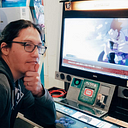Asking and answering questions
There is no silver bullet learning method for fighting games, just a set of tools and techniques that must be applied to the right person at the right time. What works for others may not work for you; what works for you now may not be what works for you a month from now.
There are some constants, however. Lab time is never wasted, even if you’re just messing around with impractical stuff or side characters. If you have a hard time motivating yourself to spend time drilling, you might like playing along to some of these guided warm-up videos I’ve started doing. Think of them like group exercise classes! It doesn’t matter that you suck at it; you’re supposed to suck at first, and the more reps you get in, the better you’ll get at it. Your controller is your instrument and your character is your song.
(People have told me that these videos have Bob Ross vibes, which is the nicest thing anyone could say because I think painting is terrifying. I’d rather get punched in the face a dozen times IRL than stare at a canvas and dare to make a single mark on it. But he makes it look chill.)
Asking questions is the other one. Fighting games are too complicated and too fast for you to understand everything happening at the same time, so you learn to ask questions to fill in the gaps as you play. When you don’t know why your opponent chose to do something, ask; when something works (or not) and you don’t know why, ask; when you don’t know what to do, ask. Asking questions is the quickest shortcut to getting good, because you don’t have to spend the time labbing or reasoning out the answers yourself, and when someone explains the answer, you get to see how they think about the game.
At first, you might not even feel like you can think of any questions to ask, because your brain and body are working so hard to keep up with the game that you don’t have any spare brainpower to think. As you keep playing, your brain will get used to the load, and you’ll be able to ask questions. And if they don’t know the answer, then you’ll have to figure it out yourself — which is also good practice.
For example: My wife Irene asked me what I-No can do after blocking Jam’s 2S, 2H string; I didn’t know for sure, so I figured we could work through it together.
“What do you think she could do?”
She thought for a second. “Maybe she could Blitz?”
“Blitz would be okay if she thinks you’re gonna mash after 2H. Should you be mashing?”
“I don’t know, should I?”
“What’s 2H on block?”
She looked it up. “-0 on block.”
“Okay, let’s look at your fast normals against I-No’s.”
She looked at the frame data again. “Jam’s fastest button is 5P, at 3f. It’s faster than all of I-No’s buttons, but it whiffs on crouching opponents.”
“Hmm. What are your 4f options?”
“Jam has 5K and 2P, I-No has 5P.”
“Nice. Your 5K will trade with 5P and beat just about everything else, and your 2P will crouch under her 5P and beat just about everything else, if you’re in range.”
“So I should mash 2P?”
“Well, hold on. Can she throw you?”
“I think so. Jam’s 2H pulls them in pretty close. Throw will beat my 2P, right?”
“Yeah. Throws in Guilty Gear are 1f and beat attacks if they’re active on the same frame. And since GG characters are throw-invincible for 5f after leaving blockstun, she can throw you, but you can’t throw her.”
“So she can just throw me. She doesn’t need to risk Blitz because she could just beat my buttons with throw anyway.”
“Yup. But she’s not throwing you. Why not?”
“Because she doesn’t know all this stuff?”
“Yeah. She hasn’t worked it out yet.”
Equipped with this information, Irene played another set with her homie’s I-No and told her that she could mash throw in that situation, then found out that if she just continued her 2H gatling into 2D, she’d hit I-No’s throw mash. Let me tell you, there is no finer move in fighting games than to teach your buddy how to beat the thing you’re doing only so you can hit them with your thing that beats their thing.
Fighting games are beautiful! By talking through her question, we made her Jam a little bit stronger than it was before, and she now has a little bit more practice working through a fighting game situation using her game knowledge and the tools in front of her — no extra lab time needed. Of course, there are still many more layers to unpack — Faultless Defense and Instant Block, invincible moves and backdashes and option selects and so much more. It’s amazing that humans can play fighting games at all, really, and yet we do, sometimes with beauty and grace, sometimes ugly and clumsy.
—
Thanks for reading! If you found this essay valuable and want to support my work, please do not hesitate to share it around on your social channels, follow me on Twitter, check out my Twitch stream (Mon-Thurs 830PM-1030PM PST), or join my Patreon.
💪😎👍❤
-patrick miller
